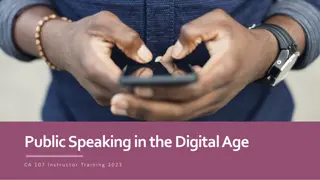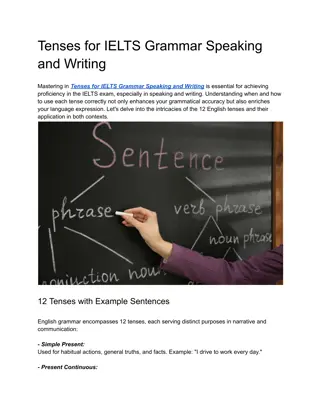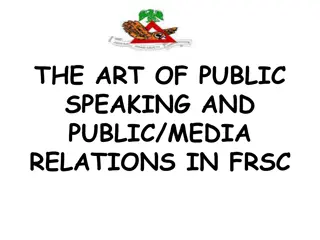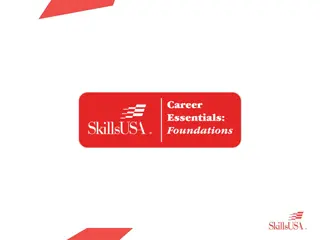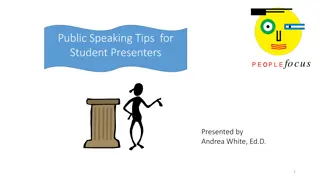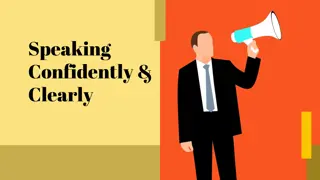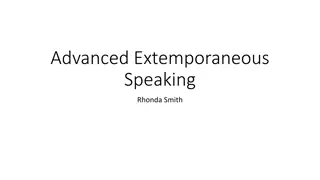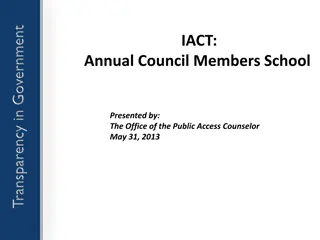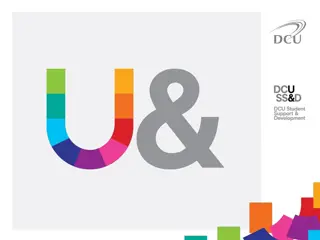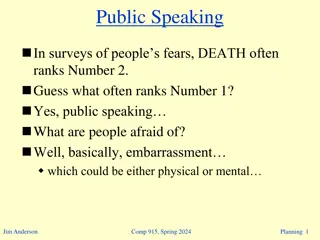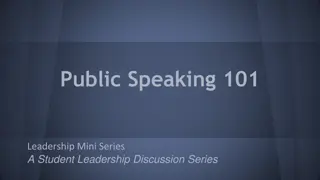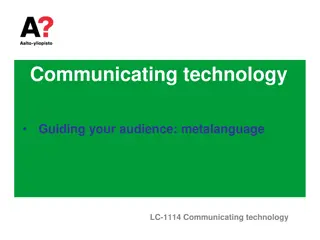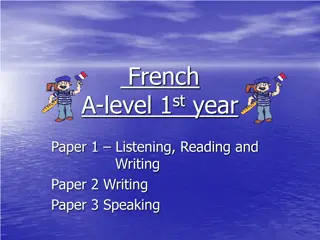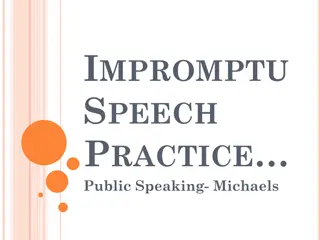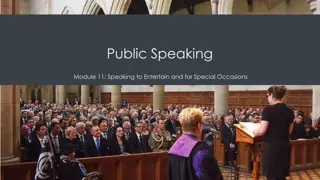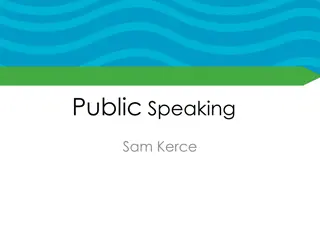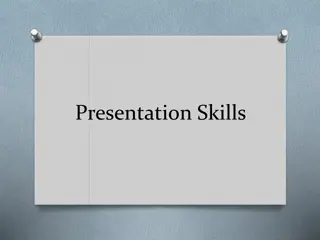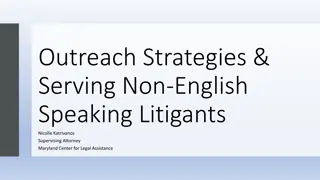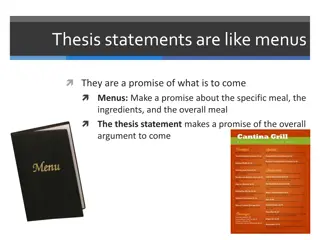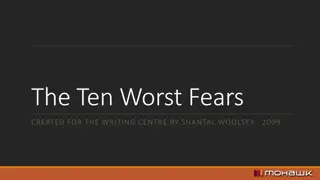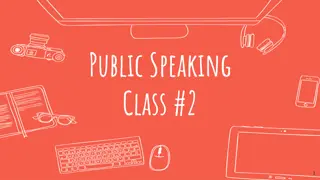Mastering Public Speaking Introductions: Strategies and Techniques
Enhance your public speaking skills with Module 7: Refining Your Speech. Dive into effective speech introductions, attention-getters, and essential components to captivate your audience. Identify characteristics, types of introductions, and strategies to craft a powerful opening, establishing credibility and engaging listeners from the start.
Download Presentation

Please find below an Image/Link to download the presentation.
The content on the website is provided AS IS for your information and personal use only. It may not be sold, licensed, or shared on other websites without obtaining consent from the author. Download presentation by click this link. If you encounter any issues during the download, it is possible that the publisher has removed the file from their server.
E N D
Presentation Transcript
Public Speaking Module 7: Refining Your Speech
Module Learning Outcomes Identify strategies for refining the various parts of a speech 7.1: Identify characteristics of an effective speech introduction 7.2: Identify characteristics of an effective speech conclusion 7.3: Identify characteristics of effective connectors and transitions 7.4: Identify effective language for spoken presentations
Learning Outcomes: Introductions 7.1: Identify characteristics of an effective speech introduction 7.1.1: Explain the purpose of a speech introduction 7.1.2: Describe the different type of introductions 7.1.3: Outline strategies to write and revise a strong introduction
Purpose of a Speech Introduction Get the audience s attention Establish credibility Provide a reason to listen Reveal the thesis Preview main points
Types of Attention Getters Quick and Easy: (low-order) Little time to prepare, audience is positively invested in your topic Rhetorical Question Quotation Audience-Centered: (higher-order) More time to prepare, audience is unfamiliar and/or positively invested in topic Refer to the audience Refer to a recent, current, or historical event Hypothetical Scenario Relevant and Stimulating: (highest-order) Ample time to prepare, audience is unfamiliar and/or disagrees with your thesis Anecdote Provocative Statement Startling Statistic or Strange Fact
Questions for a Strong Introduction 1. How long is my introduction? 2. How effective is my attention-getter 3. Have I linked my attention-getter to my topic? 4. How strong is my thesis? 5. Have I provided a reason to listen? 6. How easy is it to recall my preview? 7. How have I established my credibility?
Practice Question 1 If my attention getting device is: What would you do with one million dollars? how could I improve my introduction? A. Make it a statement instead of a question B. Tell a story about a recent lottery winner C. Use a famous quotation D. Bring in monopoly money to throw as well
Practice Question 2 What does not work about the following introduction? Andrew was walking down the street when an alien popped out in front of him. The possibility of us popping in front of aliens is not too far away. In fact, some of us in this class may find themselves booking a ticket around the moon! Today, let s discuss the future of private space tourism. We will begin by first, exploring the partnership between SpaceX and NASA, then project where we could potentially go with space tourism, and finally evaluate the impacts of introducing Earthlings to the larger intergalactic community. A. The attention getter does not link to the topic B. The preview is lacking signposts C. The thesis is unclear D. There is no reason to listen
Class Activity: Write an Introduction Write 3 different attention getters for a persuasive speech urging students to enroll in a public speaking class.
Learning Outcomes: Conclusions 7.2: Identify characteristics of an effective speech conclusion 7.2.1: Explain the purpose of a speech conclusion 7.2.2: Describe the different types of conclusions 7.2.3: Outline strategies to write and revise a strong conclusion
Purpose of a Speech Conclusion Review Main Points Restate the Thesis Provide a Lasting Thought
Types of Lasting Thoughts in Conclusions Low-Order: Rhetorical Question Quotation High-Order: Visualize the Future Call to Action Clear and direct Immediate Lowers barriers to action Focuses on the benefits to the audience Personalized to the power of audience members
Questions for a Strong Conclusion 1. How long is my conclusion? 2. Have I included any new ideas in my conclusion? 3. How easy is it to recall my review? 4. Is the thesis of the speech clearly articulated? 5. Have I linked back to my attention-getting device? 6. How effective is my lasting thought? 7. How well can I deliver my conclusion?
Practice Question 3 Identify what is wrong with the following call to action: So go out today and become a volunteer. The feeling you will get can only be matched by the friends you will meet. A. It is not immediate B. It does not lower barriers to action C. It does not focus on the benefits to the audience D. It is not clear and direct
Class Discussion: Label the conclusion Identify the elements of the following conclusion: Today, we ve discussed the future of private space tourism. We began by first, exploring the partnership between SpaceX and NASA, then projected where we could potentially go with space tourism, and finally evaluated the impacts of introducing Earthlings to the larger intergalactic community. While Andrew may not be seeing an alien any time too soon, our world is certainly expanding. One day, not too far off, we may all be gazing out at the earth instead of the moon. Review of Main Points Restating Thesis (Central Idea) Lasting Thought Link to the Attention Getter
Learning Outcomes: Connectors and Transitions 7.3: Identify characteristics of effective connectors and transitions 7.3.1: Explain the purpose of connectors and transitions in a speech 7.3.2: Describe the different types of connectors and transitions 7.3.3: Explain how to revise connectors and transitions
Purpose of Connectors and Transitions Connect Ideas Help the audience follow along
Types of Connectors and Transitions Previews Main Preview: introduction Internal Preview: each main point Reviews/Summaries Main Review: conclusion Internal Review: each main point Transitions Summary Transitions: between main points Internal Transitions: between subpoints Signposts Used with every connector and transition
Questions for Strong Connectors and Transitions 1. Are they in respective order? 2. Are they easy to recall? Recue wording Use parallelism Use alliteration and assonance Embrace repetition 3. Does each connector have signposts?
Practice Question 4 Is what type of connector is the following statement? Now that we have explored the partnership between Space X and NASA, let s now project where space tourism could take us. A. Preview B. Summary Transition C. Internal Preview D. Signpost
Practice Question 5 Where does an internal preview go in a speech? A. In the introduction B. In the conclusion C. Between main points D. At the beginning of each main point
Class Activity: Revise the Preview Improve the preview below by using Questions for Strong Connectors and Transitions : Today, let s discuss the future of private space tourism. We will begin by first, exploring the partnership between SpaceX and NASA, then project where we could potentially go with space tourism, and finally evaluate the impacts of introducing Earthlings to the larger intergalactic community
Learning Outcomes: Language for Spoken Presentations 7.4: Identify effective language for spoken presentations 7.4.1: Explain the difference between oral and written style 7.4.2: Explain how to use and choose words well for speeches 7.4.3: Describe the different language pitfalls you need to avoid as a speaker
Oral vs Written Style Spoken Written Shorter, familiar words Interesting, high-level words Shorter, simpler sentences Complex sentence structure Use Contractions Avoid contractions Informal, Colloquial expressions Formal, neutral expressions and phrases Incomplete sentences Rules of grammar are followed
Style Elements Personal Pronouns Oral: Used frequently in first person plural: We, us, our Written: Infrequently used. Instead, use third person: one, they, he/she Grammar and Sentence Structure Oral: Short thought units and sentence fragments are common Written: Complicated sentence structures that follow comprehensive grammar rules Repetition Oral: Repetition of words and phrases to emphasize ideas and organization Written: Precise and varied language to repeat ideas Colloquialisms and Tone Oral: Conversational tone using colloquialisms and contractions Written: Formal tone. Infrequent use of colloquialisms and no contractions Vocabulary Oral: Familiar, vivid, and tailored to the audience Written: High-level and tailored to the author
Choosing Your Words Abstract Intangible (no physical referent) Ideas, Concepts, Emotions Ambiguous Concrete Tangible referent Things we know through our 5 senses Uses the ladder of abstraction to become more specific Denotative Meaning Standard, dictionary-based meaning of a word Connotative Meaning Emotional responses and personal thoughts evoked by a word Jargon Exclusive, insider-based shorthand and phrases Familiar Language Common language used by the general population
Class Discussion: Connotative Meaning For each of the following words, consider: 1. Overall feeling (positive, negative, neutral) 2. 2-3 associations you make with the word Wealth Broccoli Healthcare School America
Language Pitfalls Exclusionary and Offensive Language Inappropriate Language For Yourself For the Audience For the Context For the Speech Inaccurate Word Usage Words that do not exist Not knowing the definition Malapropism Eggcorn I vs You Scenarios
Practice Question 6 Success is an example of what type of word? A. Jargon B. Concrete C. Specific D. Abstract
Class Activity: Improve your words Create a ladder of abstraction for the words: Road School Vehicle Create a more vivid words for: Large Hot Many
Quick Review The introduction, conclusion, as well as connectors and transitions are as important as the body of your speech. They serve to: Establish credibility Help the audience follow along and recall information Build interest in your topic Address each set of questions to build a strong introduction, conclusion, and transitions/connectors Language for a speech uses a different style than for writing Spoken language and structure is less formal, more accessible, and vivid Speakers should be careful to avoid language pitfalls: Exclusionary and offensive language Inappropriate language Inaccurate word usage I vs You scenarios








